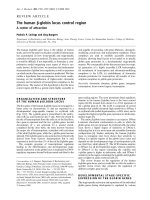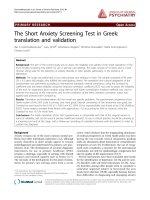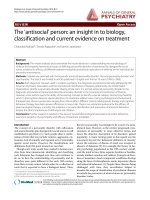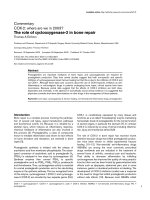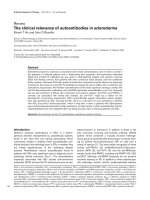Báo cáo y học: "κ The TRAF6-NFκB signaling pathway in autoimmunity: not just inflammation" ppsx
Bạn đang xem bản rút gọn của tài liệu. Xem và tải ngay bản đầy đủ của tài liệu tại đây (300.72 KB, 4 trang )
170
APC = antigen presenting cell; cTEC = thymic cortical epithelial cell; DC = dendritic cell; IκB = inhibitory κB; IL = interleukin; mTEC = medullary
thymic epithelial cell; NFκB = nuclear factor κB; NIK = NFκB inhibitory kinase; NOD = non-obese diabetic; NZB = New Zealand black; TLR = toll-
like receptor; TNF = tumor necrosis factor; TRAF6 = TNF receptor associated factor 6.
Arthritis Research & Therapy August 2005 Vol 7 No 4 Thomas
Recently, Akiyama et al. [1] described defects in thymic
negative selection and in CD4
+
CD25
+
regulatory T cell
production in mice deficient for tumor necrosis factor (TNF)
receptor associated factor (TRAF)6. Signaling through cell
surface receptors to activate nuclear factor (NF)κB and
mitogen-activated protein (MAP) kinases through adaptor
molecules, including TRAF6, is of critical importance to
survival and activation of all cells in the body, from those
regulating the immune response to epithelial cells, with which
immunocytes interact (Fig. 1). Because the same cell signaling
pathways regulate survival and activation in the periphery and
in the thymus, however, mutations or polymorphisms in the
pathway can have outcomes for the immune system that might
have been difficult to predict. This is because survival and
activation of key antigen presenting cells (APCs), medullary
thymic epithelial cells (mTECs) and dendritic cells (DCs),
involved in thymic negative selection and peripheral immunity
are regulated by a similar network of genes, which map a
pathway from TRAF6 to the NFκB family member RelB.
Thymic selection and autoimmunity
The vast majority of T cells arise in the thymus. In the fetal and
neonatal period, ‘central’ tolerance is actively maintained in
the thymus [2]. During this process, a repertoire of T cells
restricted to self-MHC displayed by the thymic cortical
epithelial cells (cTECs) is selected in each individual. In
addition, those T cells reactive to self-antigen presented by
medullary APCs, which include mTECs and medullary DCs,
are deleted by negative selection above a threshold of affinity
for self antigens presented by those APCs [3]. Because an
affinity threshold applies for central deletion of self-reactive T
cells, circulation of low-affinity self-reactive T cells in the
periphery is inevitable. Ectopic low-level expression of self-
antigens normally expressed by peripheral somatic cells in
mTECs is very common, transcriptionally activated by the aire
gene [4]. Thymic selection defects feature in the
pathogenesis of many if not all mouse models of spontaneous
autoimmune arthritis and lupus. In these models, including the
non-obese diabetic (NOD) × K/B TCR transgenic strain [5],
the New Zealand Black (NZB) lupus-prone strain [6], and the
SKG ZAP70 mutant model of spontaneous arthritis [7], a
variety of defects in the interaction of APCs and thymocytes
interfere with the normal process of negative selection, thus
permitting the release of dangerously autoreactive T cells into
the periphery, where subsequent environmental events, such
as infection, more readily trigger autoimmune disease [8]. For
example, NOD mouse thymocytes fail to induce the pro-
apoptotic gene bim after encountering high-affinity
autoantigen, thus raising the threshold for deletion [9].
ZAP70 mutant thymocytes are signaled by APCs bearing self
with lower affinity, also raising the threshold for deletion, but
are subsequently activated in the periphery by fungal beta-
glucans [7]. In contrast, NZB mice demonstrate a defective
NFκB/RelB pathway, leading to disorganization of the thymus
with associated selection defects [6].
Signaling through NF
κκ
B
NFκB is a transcription factor family whose members exist as
homodimers or heterodimers of p50/p105, p52/p100, p65
(RelA), RelB and c-Rel. Key events leading to NFκB
activation after stimulation of APCs are shown in Fig. 1. In
resting APCs, NFκB dimers are sequestered in cytoplasm in
complex with the inhibitory (I)κB family, which include the
IκBα, IκBβ, IκBε inhibitors of the canonical (or ‘standard’)
activation pathway, and the p100 inhibitory precursor of p52,
which participates with RelB in the non-canonical activation
pathway (Fig. 1) [10]. Infectious toll-like receptor (TLR)
ligands, proinflammatory cytokines such as TNF and IL-1, or
T-cell derived CD40-ligand, activate NFκB through phos-
phorylation and eventual degradation of IκB, or processing of
Viewpoint
The TRAF6-NF
κκ
B signaling pathway in autoimmunity: not just
inflammation
Ranjeny Thomas
Centre for Immunology and Cancer Research, Princess Alexandra Hospital, University of Queensland, Brisbane, Australia
Corresponding author: Ranjeny Thomas,
Published: 23 June 2005 Arthritis Research & Therapy 2005, 7:170-173 (DOI 10.1186/ar1784)
This article is online at />© 2005 BioMed Central Ltd
171
Available online />p100 to p52 as a result of phosphorylation by NFκB
inhibitory kinase (NIK), in both cases allowing translocation of
released NFκB dimers to the nucleus [10-12]. After binding
DNA, active NFκB transcription factors promote the
expression of many genes, of which the majority participate
through the canonical pathway as ‘central mediators of the
immune response’ [13]. These include cytokines, adhesion
and costimulatory molecules, and genes regulating the
oxidative burst [14].
Although other NFκB molecules contribute, the RelB subunit
has been most directly associated with functional DC
differentiation and activation, and with monocyte and
monocyte-derived DC development, with no effect on other
myeloid differentiation pathways [15-18]. However, while
maturation of DCs is defective in RelB deficient mice and
DCs from these mice induce T cell tolerance in wild-type
mice, RelB deficient mice also display defective thymic
organogenesis, reduced numbers of mTECs, reduced
negative selection, increased numbers of autoreactive T cells
in the periphery, and multi-organ inflammation [19-21].
TRAF6 and NF
κκ
B deficient mice define
elements of the central tolerance pathway
TRAF6 acts like a junction, transducing signals from the TNF
receptor superfamily, TLR/IL-1R family and CD40 to activate
the transcription factors NFκB and AP1 (Fig. 1). TRAF6-
deficient mice also demonstrate autoantibody production,
and inflammation of multiple organs including liver, lung and
pancreas. Akiyama et al. [1] show that TRAF6 is required for
the development of mTECs but not thymic medullary DCs.
Using thymic grafts depleted of hemopoietic cells, they show
that the grafted TRAF6 thymic stroma is sufficient to
recapitulate the negative selection defect, and the develop-
ment of autoimmunity, in nude mice with intact TRAF6. They
go on to show that RelB expression is undetectable in
TRAF6-deficient thymic stroma, and that RelB expression is
restored when TRAF6 is introduced into knockout mTEC
lines. In addition, the number of CD4
+
CD25
+
regulatory T
cells in TRAF6 thymus is markedly reduced. Their data
suggest that reduced regulatory T cell development, and
reduced negative selection as a result of an absence of the
selecting mTEC, are two potential mechanisms of auto-
immunity in these mice.
Implications for autoimmune disease
pathogenesis
The analysis by Akiyama et al. [1] of TRAF6-deficient mice
adds to a body of literature implicating the non-canonical
pathway of NFκB activation, not only in DC development and
function, but also in the processes of thymic organization,
mTEC development, negative selection and regulatory T cell
Figure 1
The NFκB pathway regulates inflammation, dendritic cell (DC) development and function, and thymic selection and regulatory T cell production.
The pathway is described in the text. Deficient strains marked in red display defects in thymic organization and negative selection with increased
numbers of peripheral autoreactive T cells. The two main NFκB activation pathways are marked in blue. IL, interleukin; IRAK, IL-1 receptor-
associated kinase; MAPK, mitogen-activated protein kinase; mTEC, medullary thymic epithelial cell; NFκB, nuclear factor κB; NIK, NFκB inhibitory
kinase; TLR, toll-like receptor; TNF, tumor necrosis factor; TRAF6, TNF receptor associated factor 6.
172
Arthritis Research & Therapy August 2005 Vol 7 No 4 Thomas
production. When DCs were compared in TRAF6 and RelB
deficient mice by Kobayashi et al. [22], both were shown to
have a specific defect in development of the CD4
+
CD11c
+
subset of splenic DCs as a direct effect of TRAF6/RelB in
hemopoietic cell differentiation. In contrast, thymic medullary
DCs and other subsets of splenic DCs developed normally.
As expected from the central role of TRAF6 in the NFκB
activation pathway, DCs from TRAF6 deficient mice are
unable to produce pro-inflammatory cytokines or to up-
regulate expression of costimulatory molecules in response to
TLR ligands or CD40 ligand [22]. In addition, the TRAF6-NIK-
RelB pathway has marked effects on stromal cells. TRAF6
and RelB are required for the development of mTECs and for
organization of the thymic medulla, as well as for develop-
ment of lymph nodes [19,22]. Similar disorganization is seen
in the aly/aly mutant, which carries a functional mutation in
NIK, which makes it unable to bind IKKα and thereby to
phosphorylate p100 (Fig. 1). Aly thymic grafts also induce
autoimmunity in wild-type nude recipient mice [23]. These
different mice provide a powerful demonstration of the
development of spontaneous autoimmunity due, at least in
part, to central T cell dysregulation, even when TLR ligands
and CD40 ligand are unable to activate DCs.
Could pathways related to TRAF-RelB impact
on mTEC?
Vanin-1 is a thymic epithelial cell ectoenzyme that generates
the amino-thiol cysteamine, an important mediator of oxidative
stress. It was recently shown that vanin-1 deficient mice,
which lack cysteamine in tissues, exhibit resistance to
oxidative injury due to elevated stores of glutathione, the most
potent cellular antioxidant [24]. Of interest here, vanin-1 is
normally expressed at low levels by mTECs and is up-
regulated by oxidative stress [24]. These data raise the
possibility that mTEC function may be regulated by oxidative
stress. The implication is that genes or environmental factors
that alter the oxidative/reductive state of mTECs in utero and
in neonates may influence the outcome of thymic negative
selection. Potential genetic factors have been described. A
functional polymorphism in the ncf1 gene reduces the
responsiveness of cells in rats and mice susceptible to
arthritis to oxidative stress [25]. Environmental factors are
less well characterized, although exposure to certain
infections or possibly cigarette smoke in utero or in neonates
may be sufficient to alter mTEC function.
Implications for human autoimmune diseases
Given that the same cell signaling pathways regulate survival
and activation in the periphery and in the thymus, the immune
system must balance antigen presentation and pro-
inflammatory outcomes in the periphery in response to
pathogens and other environmental inflammatory events,
along with correct signaling of TRAF6-NIK-RelB in neonates
to prevent excessive autoreactivity of the T cell repertoire and
the appropriate development and function of peripheral
APCs. The TRAF6-RelB deficient mice provide striking
examples of how an apparent immune deficiency – in NFκB
function – can also cause autoimmunity. Thus, emerging data
suggest strongly that deficiencies of the TRAF6-NFκB
pathway, and regulation of oxidation/reduction, will continue
to be found in human autoimmune diseases, and that the
thymus is implicated in its pathogenesis.
Competing interests
The author(s) declare that they have no competing interests.
References
1. Akiyama T, Maeda S, Yamane S, Ogino K, Kasai M, Kajiura F, Mat-
sumoto M, Inoue J: Dependence of self-tolerance on TRAF6-
directed development of thymic stroma. Science 2005, 308:
248-251.
2. Ardavin C: Thymic dendritic cells. Immunol Today 1997, 18:
350-361.
3. Kappler JW, Roehm N, Marrack P: T cell tolerance by clonal
elimination in the thymus. Cell 1987, 49:273-280.
4. Anderson MS, Venanzi ES, Klein L, Chen Z, Berzins SP, Turley SJ,
von Boehmer H, Bronson R, Dierich A, Benoist C, Mathis D: Pro-
jection of an immunological self shadow within the thymus by
the aire protein. Science 2002, 298:1395-1401.
5. Kouskoff V, Korganow AS, Duchatelle V, Degott C, Benoist C,
Mathis D: Organ-specific disease provoked by systemic
autoimmunity. Cell 1996, 87:811-822.
6. Valero R, Baron ML, Guerin S, Beliard S, Lelouard H, Kahn-Perles
B, Vialettes B, Nguyen C, Imbert J, Naquet P: A defective NF-
kappa B/RelB pathway in autoimmune-prone New Zealand
black mice is associated with inefficient expansion of thymo-
cyte and dendritic cells. J Immunol 2002, 169:185-192.
7. Sakaguchi N, Takahashi T, Hata H, Nomura T, Tagami T, Yamazaki
S, Sakihama T, Matsutani T, Negishi I, Nakatsuru S, Sakaguchi S:
Altered thymic T-cell selection due to a mutation of the ZAP-
70 gene causes autoimmune arthritis in mice. Nature 2003,
426:454-460.
8. Yoshitomi H, Sakaguchi N, Kobayashi K, Brown GD, Tagami T,
Sakihama T, Hirota K, Tanaka S, Nomura T, Miki I, et al.: A role for
fungal {beta}-glucans and their receptor Dectin-1 in the induc-
tion of autoimmune arthritis in genetically susceptible mice. J
Exp Med 2005, 201:949-960.
9. Liston A, Lesage S, Gray DH, O’Reilly LA, Strasser A, Fahrer AM,
Boyd RL, Wilson J, Baxter AG, Gallo EM, et al.: Generalized
resistance to thymic deletion in the NOD mouse; a polygenic
trait characterized by defective induction of Bim. Immunity
2004, 21:817-830.
10. Baldwin AS Jr: The NF-kappa B and I kappa B proteins: new
discoveries and insights. Annu Rev Immunol 1996, 14:649-
683.
11. Saccani S, Pantano S, Natoli G: Modulation of NF-kappaB
activity by exchange of dimers. Mol Cell 2003, 11:1563-1574.
12. O’Sullivan BJ, Thomas R: CD40 ligation conditions dendritic
cell antigen-presenting function through sustained activation
of NF-kappaB. J Immunol 2002, 168:5491-5498.
13. Pahl HL: Activators and target genes of Rel/NF-kappaB tran-
scription factors. Oncogene 1999, 18:6853-6866.
14. Iles KE, Forman HJ: Macrophage signaling and respiratory
burst. Immunol Res 2002, 26:95-105.
15. Platzer B, Jorgl A, Taschner S, Hocher B, Strobl H: RelB regu-
lates human dendritic cell subset development by promoting
monocyte intermediates. Blood 2004, 104:3655-3663.
16. Pettit AR, Quinn C, MacDonald KP, Cavanagh LL, Thomas G,
Townsend W, Handel M, Thomas R: Nuclear localization of
RelB is associated with effective antigen-presenting cell func-
tion. J Immunol 1997, 159:3681-3691.
17. Carrasco D, Ryseck RP, Bravo R: Expression of relB transcripts
during lymphoid organ development: specific expression in
dendritic antigen-presenting cells. Development 1993, 118:
1221-1231.
18. Martin E, O’Sullivan BJ, Low P, Thomas R: Antigen-specific sup-
pression of a primed immune response by dendritic cells
mediated by regulatory T cells secreting interleukin-10. Immu-
nity 2003, 18:155-167.
173
19. Burkly L, Hession C, Ogata L, Reilly C, Marconi LA, Olson D,
Tizard R, Cate R, Lo D: Expression of relB is required for the
development of thymic medulla and dendritic cells. Nature
1995, 373:531-536.
20. Weih F, Carrasco D, Durham SK, Barton DS, Rizzo CA, Ryseck
RP, Lira SA, Bravo R: Multiorgan inflammation and hematopoi-
etic abnormalities in mice with a targeted disruption of RelB,
a member of the NF-kappa B/Rel family. Cell 1995, 80:331-
340.
21. Laufer TM, DeKoning J, Markowitz JS, Lo D, Glimcher LH: Unop-
posed positive selection and autoreactivity in mice express-
ing class II MHC only on thymic cortex. Nature 1996, 383:
81-85.
22. Kobayashi T, Walsh PT, Walsh MC, Speirs KM, Chiffoleau E, King
CG, Hancock WW, Caamano JH, Hunter CA, Scott P, et
al.:TRAF6 is a critical factor for dendritic cell maturation and
development. Immunity 2003, 19:353-363.
23. Kajiura F, Sun S, Nomura T, Izumi K, Ueno T, Bando Y, Kuroda N,
Han H, Li Y, Matsushima A, et al.: NF-kappa B-inducing kinase
establishes self-tolerance in a thymic stroma-dependent
manner. J Immunol 2004, 172:2067-2075.
24. Berruyer C, Martin FM, Castellano R, Macone A, Malergue F,
Garrido-Urbani S, Millet V, Imbert J, Dupre S, Pitari G, et al.:
Vanin-1-/- mice exhibit a glutathione-mediated tissue resis-
tance to oxidative stress. Mol Cell Biol 2004, 24:7214-7224.
25. Olofsson P, Holmberg J, Tordsson J, Lu S, Akerstrom B, Holmdahl
R: Positional identification of Ncf1 as a gene that regulates
arthritis severity in rats. Nat Genet 2003, 33:25-32.
Available online />


